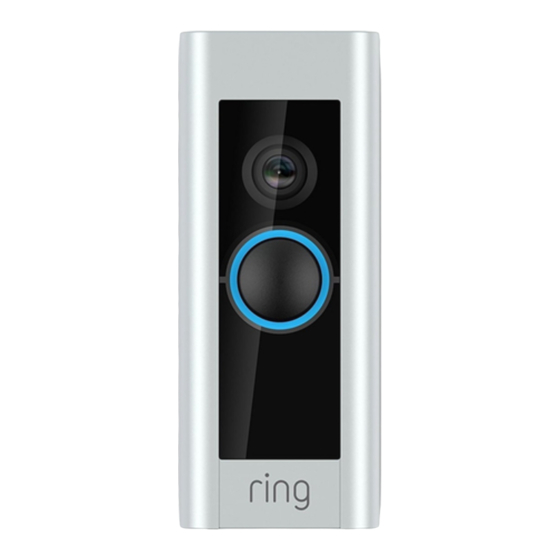
ring VIDEO DOORBELL PRO Setup And Installation Manual
Hide thumbs
Also See for VIDEO DOORBELL PRO:
- User manual ,
- Manual (36 pages) ,
- Installation manual (13 pages)
Advertisement
Quick Links
2
2
Welcome
Hi, I'm Jamie Siminoff,
inventor of your Ring Video
Doorbell Pro.
Congratulations on
purchasing the world's most
advanced doorbell!
VIDEO DOORBELL PRO
With Ring, you'll always
Setup and
know who's at your door,
Installation Guide
whether you're across town,
on vacation, or just can't
come to the door. As my
wife likes to say, "Ring is like
caller ID for the front door."
3
3
4
4
Step 1
If you need extra
Download the Ring app
help...
The Ring app will walk you through the
entire process outlined in this manual,
Our support team is
but in case you like reading small print
available 7 days a week, and
our online help center is
we've included this manual as well.
accessible 24/7.
Visit:
ring.com/app
Visit our online help
center at:
ring.com/help
Visit the online setup guide
Contact our support team
We have an online guide with videos
directly at:
and tutorials on setting up and using
your Ring Video Doorbell Pro.
800-656-1918
help@ring.com
View the online setup guide at:
ring.com/setup
What You'll Need to Install Your Ring Doorbell
5
5
Step 3
Step 2
Check out all the cool stuff in the box
Say "Hello" to your Ring Video Doorbell Pro
1 Ring Screwdriver - Use the Phillips end for tightening the
Front
Back
screws that hold the doorbell wiring and the doorbell in place,
and the star-shaped end for tightening the security screw.
3 Anchors - For concrete, stucco, or brick installs.
Setup
Mounting
Terminals
button
holes
1 Drill Bit - Use to drill holes if using the anchors.
(attach your
existing wiring
here)
3 Screws - For attaching Ring Doorbell to your wall.
2 Security Screws - Use one to secure the faceplate.
2 Extra Wires - Use these if you have trouble attaching your
existing wiring to the back of your Ring Doorbell.
4 Faceplates
Pick the one that
2 Wire connectors - Use to connect the extra wire (above)
best matches your
to your existing wiring.
home...or your mood.
1 Pro Power Kit - Install the Pro Power Kit after installing
Change it any time.
your Ring Doorbell. It's got its own manual.
Installing Anchors (optional)
6
6
7
Step 4
Step 5
Remove your existing
Install anchors (on
doorbell
stucco, brick, or
concrete)
To get started, shut off
power at the breaker.
On stucco, brick, or
Then remove your existing
concrete, use the provided
doorbell from the wall and
bit to drill two holes in your
wall, and install the anchors.
disconnect the wires.
If you're installing on wood
As a reminder, this
entire process is
or siding, put the anchors
explained in a video inside
in that drawer of stuff you
the Ring app.
never use and skip this step.
8
8
Advertisement

Summary of Contents for ring VIDEO DOORBELL PRO
- Page 1 Check out all the cool stuff in the box Say “Hello” to your Ring Video Doorbell Pro Welcome If you need extra Download the Ring app Step 4 1 Ring Screwdriver - Use the Phillips end for tightening the Step 5 Front Back Hi, I’m Jamie Siminoff, help…...
- Page 2 Ring app. White Flashing The instructions are You can toggle alerts for rings or RING, ALWAYS HOME, and CHIME are trademarks of Bot Home Automation, Inc. software Ring screwdriver. motions on or off in the Ring app.
- Page 3 Federal Communication Commission Interference Statement This equipment has been tested and found to comply with the limits for a Class B digital device, pursuant to Part 15 of the FCC Rules. These limits are designed to provide reasonable protection against harmful interference in a residential installation. This equipment generates, uses and can radiate radio frequency energy and, if not installed and used in accordance with the instructions, may cause harmful interference to radio communications.
- Page 4 This device complies with Industry Canada’s licence-exempt RSSs. Operation is subject to the following two conditions: (1) This device may not cause interference; and (2) This device must accept any interference, including interference that may cause undesired operation of the device.
















Need help?
Do you have a question about the VIDEO DOORBELL PRO and is the answer not in the manual?
Questions and answers